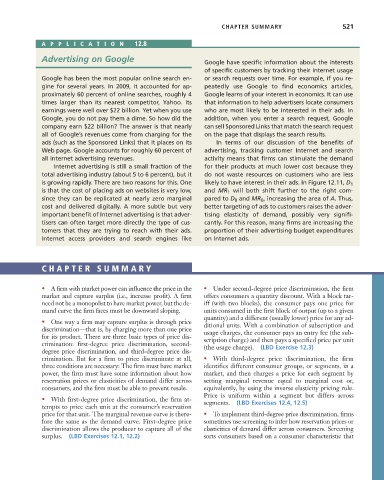Page 547 - Microeconomics, Fourth Edition
P. 547
c12capturingsurplus.qxd 7/22/10 10:41 AM Page 521
CHAPTER SUMMARY 521
APPLICA TION 12.8
Advertising on Google Google have specific information about the interests
of specific customers by tracking their Internet usage
Google has been the most popular online search en- or search requests over time. For example, if you re-
gine for several years. In 2009, it accounted for ap- peatedly use Google to find economics articles,
proximately 60 percent of online searches, roughly 4 Google learns of your interest in economics. It can use
times larger than its nearest competitor, Yahoo. Its that information to help advertisers locate consumers
earnings were well over $22 billion. Yet when you use who are most likely to be interested in their ads. In
Google, you do not pay them a dime. So how did the addition, when you enter a search request, Google
company earn $22 billion? The answer is that nearly can sell Sponsored Links that match the search request
all of Google’s revenues come from charging for the on the page that displays the search results.
ads (such as the Sponsored Links) that it places on its In terms of our discussion of the benefits of
Web page. Google accounts for roughly 60 percent of advertising, tracking customer Internet and search
all Internet advertising revenues. activity means that firms can stimulate the demand
Internet advertising is still a small fraction of the for their products at much lower cost because they
total advertising industry (about 5 to 6 percent), but it do not waste resources on customers who are less
is growing rapidly. There are two reasons for this. One likely to have interest in their ads. In Figure 12.11, D 1
is that the cost of placing ads on websites is very low, and MR 1 will both shift further to the right com-
since they can be replicated at nearly zero marginal pared to D 0 and MR 0 , increasing the area of A. Thus,
cost and delivered digitally. A more subtle but very better targeting of ads to customers raises the adver-
important benefit of Internet advertising is that adver- tising elasticity of demand, possibly very signifi-
tisers can often target more directly the type of cus- cantly. For this reason, many firms are increasing the
tomers that they are trying to reach with their ads. proportion of their advertising budget expenditures
Internet access providers and search engines like on Internet ads.
CHAPTER SUMMAR Y
• A firm with market power can influence the price in the • Under second-degree price discrimination, the firm
market and capture surplus (i.e., increase profit). A firm offers consumers a quantity discount. With a block tar-
need not be a monopolist to have market power, but the de- iff (with two blocks), the consumer pays one price for
mand curve the firm faces must be downward sloping. units consumed in the first block of output (up to a given
quantity) and a different (usually lower) price for any ad-
• One way a firm may capture surplus is through price ditional units. With a combination of subscription and
discrimination—that is, by charging more than one price usage charges, the consumer pays an entry fee (the sub-
for its product. There are three basic types of price dis- scription charge) and then pays a specified price per unit
crimination: first-degree price discrimination, second- (the usage charge). (LBD Exercise 12.3)
degree price discrimination, and third-degree price dis-
crimination. But for a firm to price discriminate at all, • With third-degree price discrimination, the firm
three conditions are necessary: The firm must have market identifies different consumer groups, or segments, in a
power, the firm must have some information about how market, and then charges a price for each segment by
reservation prices or elasticities of demand differ across setting marginal revenue equal to marginal cost or,
consumers, and the firm must be able to prevent resale. equivalently, by using the inverse elasticity pricing rule.
Price is uniform within a segment but differs across
• With first-degree price discrimination, the firm at- segments. (LBD Exercises 12.4, 12.5)
tempts to price each unit at the consumer’s reservation
price for that unit. The marginal revenue curve is there- • To implement third-degree price discrimination, firms
fore the same as the demand curve. First-degree price sometimes use screening to infer how reservation prices or
discrimination allows the producer to capture all of the elasticities of demand differ across consumers. Screening
surplus. (LBD Exercises 12.1, 12.2) sorts consumers based on a consumer characteristic that

